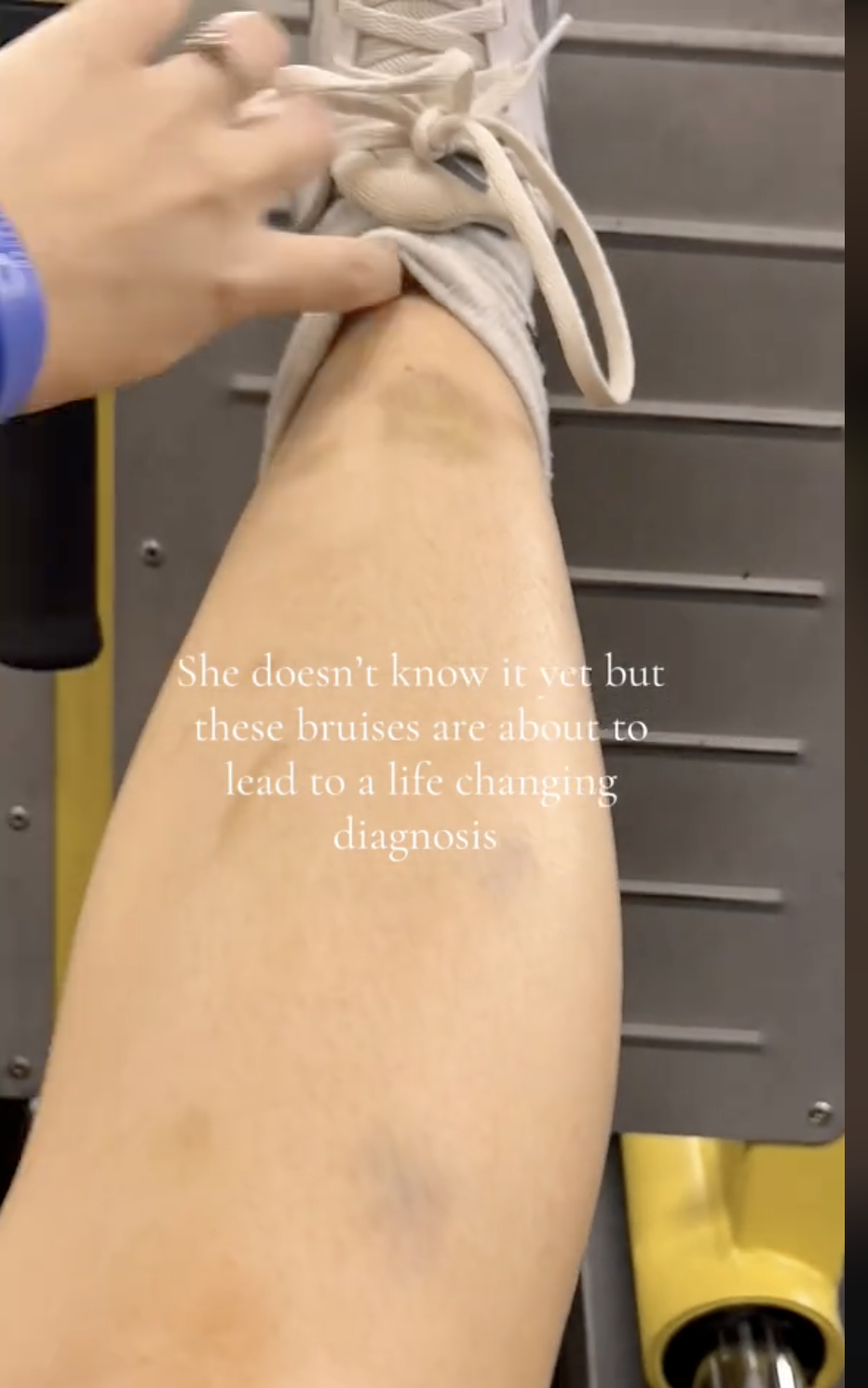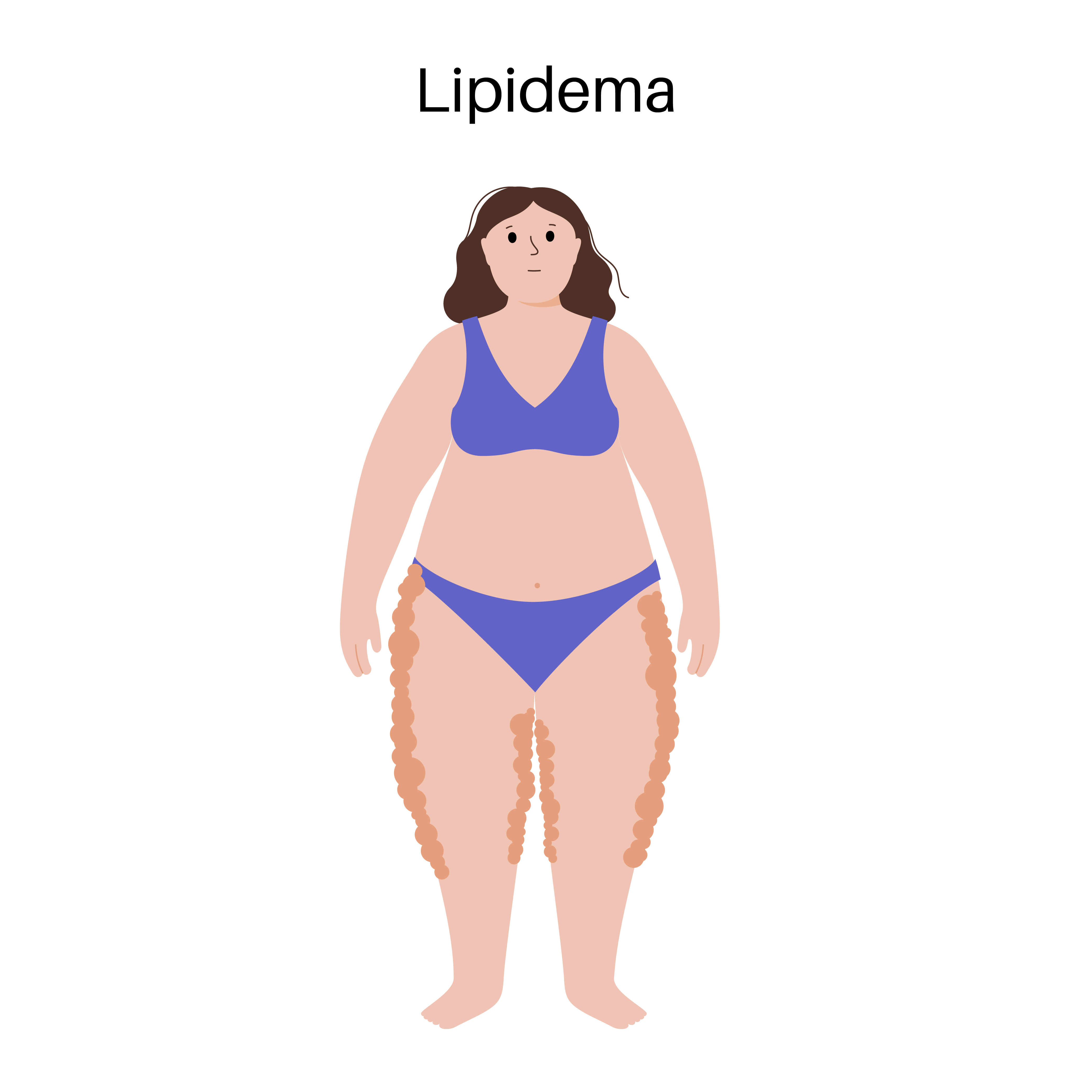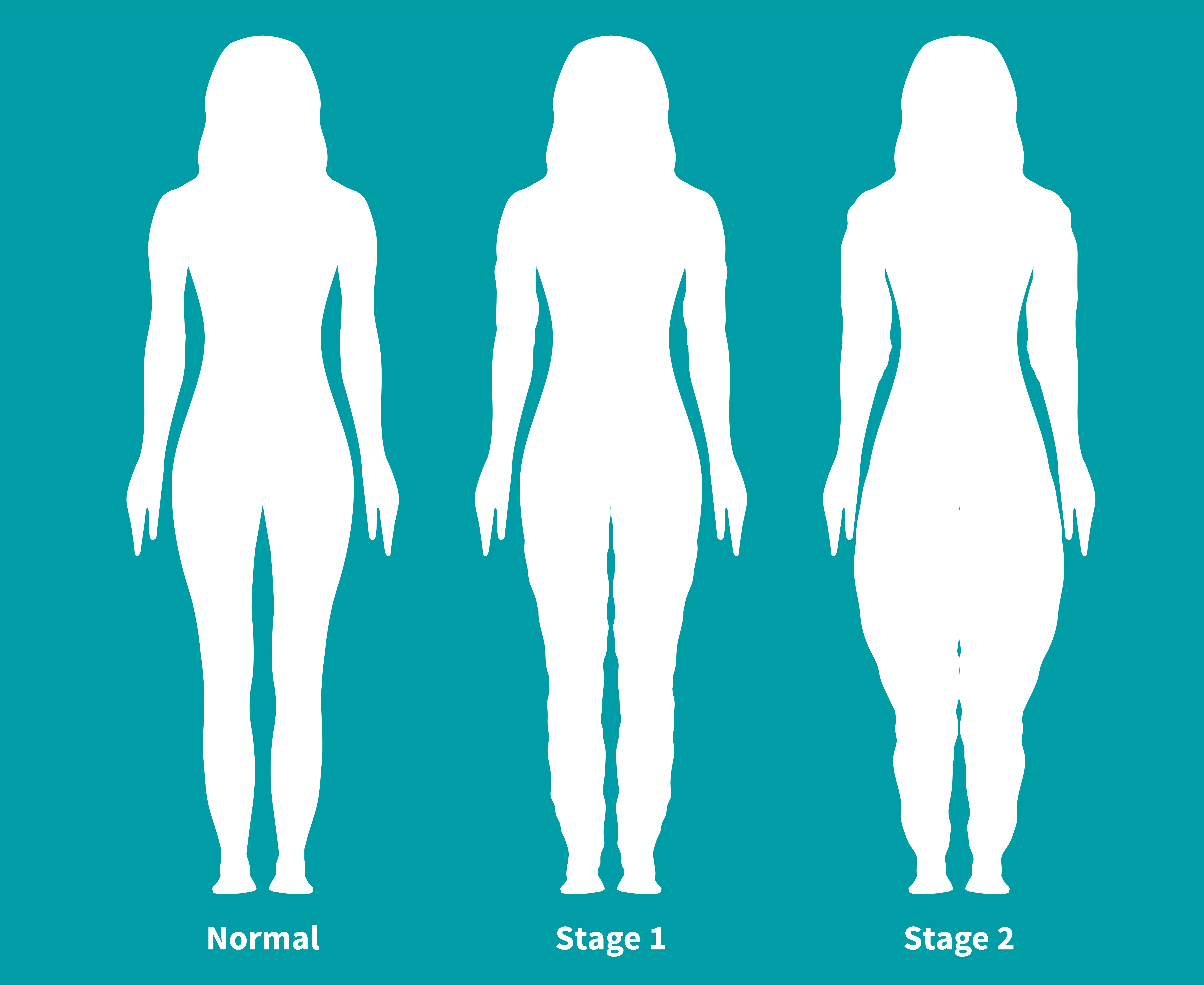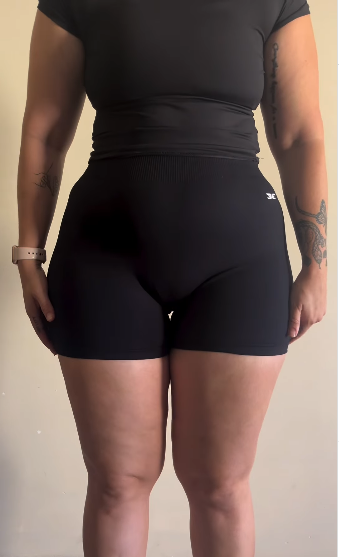
Her hips were bruised after squats. Her shoulders got bruised from a barbell. Even her dog brushing past her leg caused pain. These were more than just bruises, but she just didn’t know it yet.
Taylor Omalley had been raising concerns about her symptoms for years. Despite consultations with general practitioners, specialists, and even referrals during pregnancy, nothing led to a diagnosis. Most explanations were dismissive, and tests came back normal.

Taylor Omalley’s bruised leg as seen in a post dated May 14, 2025 | Source: TikTok/pt_tayloromalley
It wasn’t until she found an unfamiliar medical term on social media that she began reconsidering everything she had been told. The process that followed included months of waiting, a formal diagnosis, and a series of changes to her lifestyle.

Taylor Omalley’s bruised leg as seen in a post dated May 14, 2025 | Source: TikTok/pt_tayloromalley
Omalley bruised easily for most of her life. In high school, it became a running joke among her friends. There were no other symptoms that seemed alarming, and her parents didn’t look further into it. She didn’t think it was unusual enough to raise concern.
During her first pregnancy, she mentioned it to her midwife, who, as a precaution, referred her to a blood specialist. Tests were conducted, but her bloodwork came back normal. With nothing flagged, the concern was dismissed.
In the years that followed, she raised the issue with multiple doctors. Some referred her to specialists, but nothing came of it. Others told her not to worry, repeating phrases like “everyone gets bruises” or “some people just bruise easier than others.” The consultations ended without further investigation.
Her legs continued to bruise regularly. Often, she couldn’t explain how the bruises got there. The marks became part of her routine, and no one around her questioned them anymore. She eventually came across an Instagram post that mentioned lipedema, a condition she had never heard of.
According to the Lipedema Foundation, it is a chronic disease that occurs almost exclusively in women. It is marked by the symmetrical buildup of painful, fibrotic fat, usually in the legs, thighs, buttocks, and sometimes the arms.
It typically spares the hands and feet, creating a visible cuffing effect at the wrists or ankles. The disease is not caused by obesity and does not respond to standard weight loss methods such as diet, exercise, or bariatric surgery. It is often triggered or worsened during hormonal events like puberty, pregnancy, or menopause.
The most cited symptoms of lipedema include tenderness, pain, heaviness in the limbs, chronic fatigue, and easy bruising. The affected areas may also present with a nodular or dimpled texture due to underlying fibrotic tissue.
Some patients experience swelling (edema) and joint hypermobility. The condition can begin or worsen during hormonal changes, particularly puberty, pregnancy, or menopause.

A flat vector illustration depicting the Lipedema disease concept: Abnormal fat accumulation in the lower body, affecting the buttocks, hips, and calves. Characterized by swelling, cellulite, and disproportionate weight gain | Source: Getty Images
Reading through the criteria, Omalley recognized every symptom. “I realized I had all of the symptoms,” she said. But she waited a year before bringing it up with her general practitioner, whose reaction was supportive. However, the doctor told her that getting a diagnosis would be difficult.
There was no standard test, and most general practitioners weren’t trained to identify it. A referral would require finding someone who specializes in the condition. “And that’s not easy,” she was told.
She contacted a surgeon, hoping to move forward. Instead, she received a long email reply. The message told her not to waste his time unless she had specific symptoms, referred to as “A, B, and C.” Omalley met all of them.
Still, the tone of the message made her question herself. “It made me doubt myself — made me think maybe I was overreacting,” she shared. Months passed before she was able to secure an appointment. Her general practitioner encouraged her to continue pursuing it, and she eventually booked a consultation.
Eventually, Omalley was formally diagnosed with lipedema. The confirmation brought mixed emotions. She was relieved at finally having an explanation, but the news was difficult to process. On the first day, she realized that no matter what she did, it was unlikely to change the underlying condition.
She had spent a decade committed to health and fitness as a personal trainer, following a structured routine as she worked toward a specific physique. The diagnosis explained why those efforts hadn’t produced the changes she expected.
Though not meaningless, her past training could never override the physiological limits imposed by lipedema. The diagnosis also made her think back on how her pain had been received. Even slight contact, like her dog brushing against her leg, could cause significant discomfort.
People around her had often said it didn’t hurt or that she was exaggerating. After she shared the diagnosis, her parents acknowledged that the pain had been real all along and recalled the X-rays she had undergone in the past. “Being validated for my feelings makes me feel so much better,” she stated.
Following her diagnosis, Omalley began treatment for lipedema. She was advised to wear compression garments daily for at least three hours. Putting them on took ten minutes and often made her feel nauseous.
She incorporated daily lymphatic drainage massage into her evening routine, which she found relaxing and a consistent part of her night schedule. To support circulation and general health, she made 10,000 steps a day a non-negotiable goal.
Her exercise routine changed completely. She transitioned from high-intensity training to low-impact movement and added an extra rest day. Movements she had once performed regularly, which caused bruising on her hips and shoulders, required her to adapt her workouts accordingly.
Her diet also changed. She began a keto-like regimen, focusing on reducing carbohydrates while monitoring which foods triggered inflammation. Alongside these changes, she started a GLP-1 injection, which helped to reduce appetite and what she called “food noise.”
She referred to new studies suggesting that GLP-1 therapy may help break down lipedema fat cells, though not remove them entirely. She increased her water intake to three liters per day and began taking supplements to support her muscles, joints, and immune system.
According to the Cleveland Clinic, lipedema is frequently misdiagnosed due to its similarity to obesity and lymphedema. While some sources estimate its prevalence at one in 72,000 people, others suggest that up to 11 percent of women worldwide may be affected.

3D isometric flat vector illustration depicting Lipedema and overweight-related concerns | Source: Getty Images
The condition is extremely rare in males. Lipedema is categorized into five types, depending on where the fat accumulates.
- Type I affects the area between the belly button and the hips
- Type II spans from the pelvis to the knees
- Type III extends down to the ankles
- Type IV involves the shoulders and wrists
- Type V affects the area between the knees and ankles.

Teal silhouette illustration depicting a woman at various stages of Lipedema, contrasted with a normal body type | Source: Getty Images
Omalley did not specify which type she had, but her symptoms focused on her waist, hips, and legs.
Treatments are designed to manage symptoms rather than reverse the condition. In addition to compression garments, dietary changes, and GLP-1 therapy, options include swimming, biking, or walking to support mobility and reduce swelling.
Exercising in water is often recommended to relieve joint pressure. Noninvasive approaches such as lymphatic drainage massage, complex decongestive therapy with compression wraps, and pneumatic compression devices are also used.

Silhouette illustration of a woman, comparing normal legs with the effects of Lipedema | Source: Getty Images
Skin moisturizers and medications like phentermine, metformin, resveratrol, diosmin, and selenium can help manage inflammation and other symptoms. Antioxidant herbal medicine may also be incorporated into care plans.
Besides adjusting every part of her routine, Omalley shares her experience more actively. On September 20, 2024, months before the official diagnosis, she shared a photo reflecting on her weight loss progress.
Her caption read, “Feeling super proud of myself this morning as I look at how far I have come in the last couple months. I achieved this while still eating the foods I love (pizza and chocolate), minimal workouts… while also having a major hip surgery putting me out of action for a while.”
She invited those looking for similar results to message her about upcoming coaching opportunities. By May 3, 2025, she had lost 15 kilograms.
In an Instagram post titled “What I eat in a day (15kg down),” she listed her meals as “Bacon and egg muffin, Chili con carne (cauliflower rice), Protein yogurt, Mexican chicken, potato, pumpkin, and vegetables, and Ice cream.”
In the caption, she added, “It doesn’t have to be boring and it doesn’t have to be hard. Find what you like and make it work. Even better… Let me teach you how and take all the guess work out for you.”
On May 14, 2025, she posted a TikTok video showing extensive bruising on her legs. The caption explained her long history of trying to get answers.
She also clarified, “Easy bruising is one of the main symptoms of lipedema. It all makes sense now. I pushed to see someone who knew more about this condition. There’s no way to stop the bruising but at least I know I’m not crazy.”
Less than two weeks later, on May 27, 2025, she posted an Instagram video with text over the screen reading, “2.4kgs down, chronic foot pain almost completely gone, feeling positive, feeling less bloated, enjoying my nightly lymphatic drainage massage, so relaxing.”
The caption added that she was a few weeks post-diagnosis and one week into treatment. She noted the weight loss came entirely from her waist, which she said was expected, while her legs would take longer to change. She closed the caption with, “I’m here for it. Stay tuned for week 2.”

Taylor O’Malley’s Instagram post, dated May 17, 2025 | Source: Instagram\pt_tayloromalley
The response to her posts has been overwhelmingly positive. Her followers left messages of encouragement and support. One wrote, “You are incredible 😍,” while another cheered her on, “YES TAY ❤️ Looking amazing!” Others commented, “Get it girl! 🔥🙌,” “Hot mumma 🔥😍,” and “So amazing 🔥🔥.”
Amid the praise, there were also comments urging her to explore other possible diagnoses. Some viewers suggested she get tested for leukemia. Omalley addressed this directly, noting that she had already undergone those tests and that the information was included, though not everyone took the time to read it.

Taylor O’Malley’s post dated May 17, 2025 | Source: Instagram/pt_tayloromalley
More meaningful to her were the women who saw their own symptoms reflected in her experience. She said that many had reached out to thank her, and several expressed interest in a support group she created following her diagnosis. Encouraged by the response, she decided to take her work further.
With a background in both nursing and personal training, Omalley began coaching clients with lipedema. She connected with potential clients through the specialist who diagnosed her. She explained that her dual background allowed her to offer guidance from a clinical and fitness-informed perspective.
“Since I have a nursing background as well, it’s kind of a win-win,” she said. “They get someone who understands what they’re going through.”
She also used her growing platform to speak publicly about the misunderstandings surrounding the condition. “People think you’re just fat because they don’t know,” she said.
To others living with unexplained symptoms, she offered a message of persistence, saying, “You know your body more than anyone else. So if you strongly think something’s wrong, keep pushing until someone listens — because sometimes you have to make them listen.”
What began as an overlooked symptom is now the basis of her work. Through her own experience, Omalley has built a space for others to ask the same questions she once asked and to be taken seriously when they do.
Để lại một phản hồi